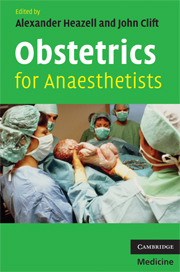Book contents
- Frontmatter
- Contents
- List of contributors
- Foreword
- Preface
- Acknowledgements
- List of abbreviations
- 1 Maternal physiology and obstetrics
- 2 Antenatal care
- 3 Induction of labour
- 4 Normal labour
- 5 Abnormal labour
- 6 Fetal monitoring
- 7 Pre-eclampsia and hypertensive disorders of pregnancy
- 8 Operative obstetrics
- 9 Obstetric haemorrhage
- 10 Thromboembolic disorders of pregnancy
- 11 Infection
- 12 Life support in obstetrics
- 13 Drugs in obstetrics
- 14 Confidential enquiries into fetal, neonatal and maternal death
- Appendix 1 Adult Advanced Life Support Algorithm
- Appendix 2 The Management of Postpartum Haemorrhage Algorithm
- Appendix 3 Emergency Management of Eclamptic Fit Algorithm
- Index
- References
11 - Infection
Published online by Cambridge University Press: 21 August 2009
- Frontmatter
- Contents
- List of contributors
- Foreword
- Preface
- Acknowledgements
- List of abbreviations
- 1 Maternal physiology and obstetrics
- 2 Antenatal care
- 3 Induction of labour
- 4 Normal labour
- 5 Abnormal labour
- 6 Fetal monitoring
- 7 Pre-eclampsia and hypertensive disorders of pregnancy
- 8 Operative obstetrics
- 9 Obstetric haemorrhage
- 10 Thromboembolic disorders of pregnancy
- 11 Infection
- 12 Life support in obstetrics
- 13 Drugs in obstetrics
- 14 Confidential enquiries into fetal, neonatal and maternal death
- Appendix 1 Adult Advanced Life Support Algorithm
- Appendix 2 The Management of Postpartum Haemorrhage Algorithm
- Appendix 3 Emergency Management of Eclamptic Fit Algorithm
- Index
- References
Summary
Prophylaxis and Screening
Infection occurring in pregnancy can result in significant morbidity and mortality for both mother and child. Depending on the type of infection, there is an increased incidence of preterm delivery, intrauterine growth restriction, intrauterine and infant death and mother-to-child transmission of infection.
Screening is performed routinely for the following infections:
Asymptomatic bacteriuria, by midstream urine culture. Treatment reduces the risk of maternal pyelonephritis and preterm birth.
Serological screening of hepatitis B virus. Effective postnatal intervention reduces the risk of mother-to-child transmission in future pregnancies.
Serological testing for HIV enables effective antenatal planning to reduce vertical transmission rates.
Rubella-susceptibility screening enables postnatal vaccination to protect future pregnancies.
Syphilis screening is also offered because treatment is beneficial to mother and fetus.
Pregnant women are advised of primary prevention measures to avoid contact with chickenpox (varicella-zoster virus), cytomegalovirus, Toxoplasma (cat litter/faeces) and Listeria (soft cheese/pate).
Planned Caesarean section for infection prophylaxis
A planned Caesarean section is recommended as an intervention in the following groups to reduce the risk of mother-to-child transmission:
HIV-positive women who are not taking highly active antiretroviral therapy (HAART)
HIV-positive women with a detectable viral load or low CD4 cell count
Pregnant women who are co-infected with hepatitis C and HIV
Women with primary genital herpes simplex virus infection occurring in the third trimester of pregnancy
Prophylaxis of infection related to obstetric procedures
Obstetric procedures such as Caesarean section, manual removal of placenta and 3rd degree tear repair are associated with a high rate of post-operative infection.
Keywords
- Type
- Chapter
- Information
- Obstetrics for Anaesthetists , pp. 130 - 135Publisher: Cambridge University PressPrint publication year: 2008

